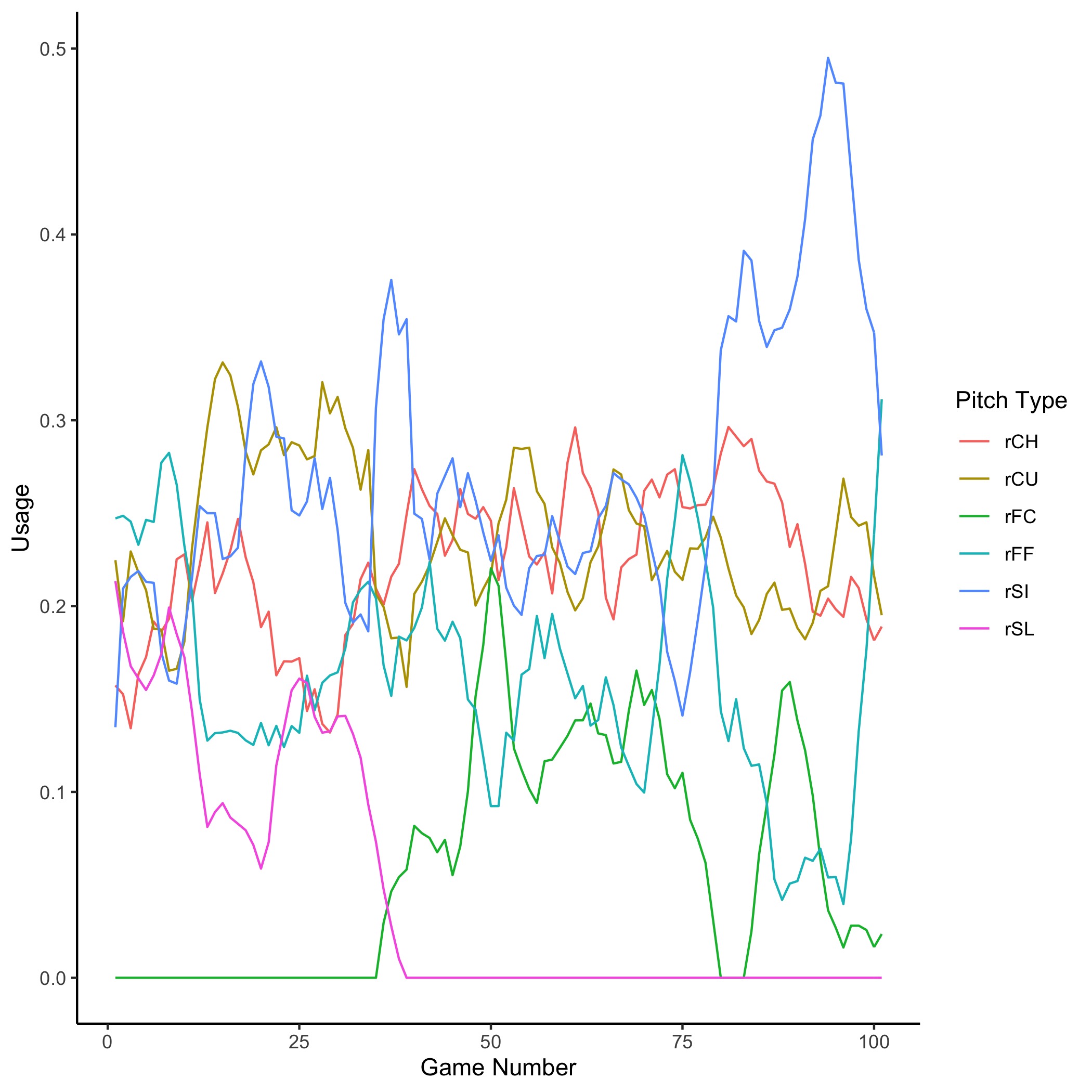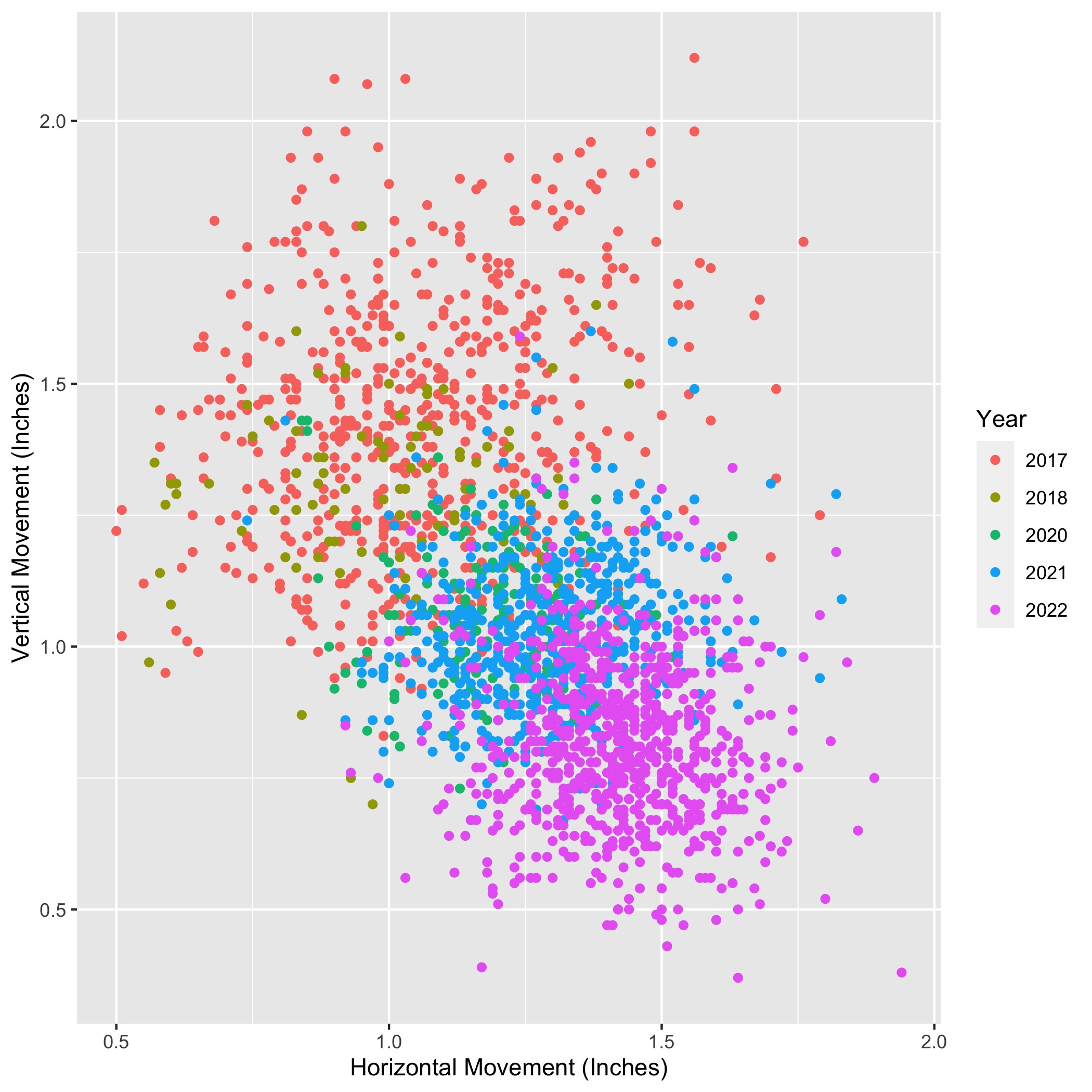Premise 1: I am a huge Yankees fan.
Premise 2: I am a huge Jordan Montgomery fan.
Conclusion: I was Not happy when the Bombers dished him at the deadline on a whim.
This was an especially tough pill to swallow because it meant that they were committed to having Domingo Germán, and his career-low velocity and swinging-strike rate, fill the void in the rotation brought about by Luis Severino’s lat injury. But the trade also hurt because I’ve loved following Montgomery from the start of his career and reveled in witnessing his evolution as a pitcher.
Just from the standpoint of pitch mix, Montgomery has been fairly volatile. Excluding 2019 because he threw all of four innings across two appearances in his return from Tommy John, consider his five-game rolling average usages (per Baseball Savant) across his career. I chose five games because Montgomery has made exactly five starts for the Cardinals:

Something stood out to me right away. After dipping to nearly a career-low five-game average of 14.1% after his last start of 2021, Montgomery’s sinker usage ballooned to a career-high 49.5% just 10 days before he was dealt to the Cards (see what I did there). Subsequently, it has cratered to 28.1%, his lowest since this April. The Cardinals made a significant and immediate alteration. Why?
Baseball Savant’s pitch-type linear weights describe the average number of runs prevented from throwing a pitch, including shifts towards more favorable counts. They list Montgomery’s sinker as having a RV/100 of -1.3 this year, indicating that it has prevented 1.3 runs per 100 tosses, making it his most effective pitch. Why reduce the usage of his least-hittable offering?
One explanation might be that the Cards see the sinker’s success as unsustainable; 2020 was the only other season in which the sinker had a negative (i.e., it prevented runs) RV/100. But there is reason to believe that the worm-killer is a different pitch now. The graph below displays the sinker’s horizontal movement vs. its vertical movement, with different colors indicating different seasons. As Montgomery has gained experience, his sinker has generated less rise (i.e., more sink) and more arm-side run (movement away from right-handed hitters):

The shift is clearly visible to the naked eye as well. Here is the sinker in 2017, dodging the bat of Robbie Grossman:
It looks like a run-of-the-mill two-seam fastball, pretty flat with a touch of run. Plus, the pitch was 1.3 MPH slower on average that year than it has been this year. Now check out this deuce from Aug. 17 that nets a C.J. Cron whiff:
The pitch falls off a table now, and it still tails away from the right-handed Cron. This shift has been rewarding, netting the offering a career-high whiff% and career-low xWOBA against it, despite Montgomery turning to it at easily the highest clip of his career. So why would the Cards up the usage of his four-seamer at the sinker’s expense?
Another potential reason is that they think Montgomery’s four-seamer sets up his other offerings better than the sinker. According to the graph above, the four-seamer has been the primary beneficiary of the sinker’s decrease in usage. The four-seamer stands at a 31.1% usage across five starts in a Redbirds’ uniform, a career-high. The only time in his career that he turned to the four-seamer more often than the sinker across an entire season was in 2018; that year, his curveball (-1.9) and changeup (-2.1) saw career-best RV/100 numbers. Set up by the sinker and four-seamer, these two pitches have historically been Montgomery’s bread and butter (with the cutter and slider, used least often, serving only as show-me pitches). I say this because the only season in which both the curveball and changeup put up positive RV/100 numbers was in 2020 (which happens to be the other year in which Montgomery utilized his sinker more than any other pitch). Interestingly, the curve has been solid this year (-0.9), but the changeup has been middling (0.3).
To truly put this theory to the test, I looked at the whiff rates for the curve and change immediately following Montgomery sinkers and four-seamers. The results are shown below:
Both offspeed pitches have netted more whiffs immediately following sinkers, both throughout Montgomery’s career and this year in particular. The curveball has been better post-sinker and worse post-four-seamer this year, indicating that it might pair especially well with the new-and-improved worm-burner. The changeup has seen its whiffs decline on pitches following either type of fastball; perhaps its mediocre run values this year are due to a general decrease in effectiveness rather than a failure to play off of the sinker.
To me, this move by the Cardinals is a bit of a head-scratcher. Sure, Montgomery has seen success with them so far, pitching to a 1.76 ERA, but his xFIP and SIERA both stand at more than a run higher. The ERA estimators still peg him at a sub-3.00 ERA, but FanGraph’s Ben Clemens chalks that more-limited improvement up to better location rather than the pitch-mix change working to Montgomery’s benefit. If he went back to the sinker once again, maybe that would truly legitimize his sparkling ERA.
Photos by Joe Puetz/Getty Images, Matt Marton-USA TODAY Sports, Scott Kane/Getty Images, and No Revisions/Unsplash | Featured Image by Ethan Kaplan (@DJFreddie10 on Twitter and @EthanMKaplanImages on Instagram)

